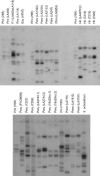Natural variation in the Pto pathogen resistance gene within species of wild tomato (Lycopersicon). I. Functional analysis of Pto alleles
- PMID: 15944360
- PMCID: PMC1456525
- DOI: 10.1534/genetics.104.039339
Natural variation in the Pto pathogen resistance gene within species of wild tomato (Lycopersicon). I. Functional analysis of Pto alleles
Abstract
Disease resistance to the bacterial pathogen Pseudomonas syringae pv. tomato (Pst) in the cultivated tomato, Lycopersicon esculentum, and the closely related L. pimpinellifolium is triggered by the physical interaction between plant disease resistance protein, Pto, and the pathogen avirulence protein, AvrPto. To investigate the extent to which variation in the Pto gene is responsible for naturally occurring variation in resistance to Pst, we determined the resistance phenotype of 51 accessions from seven species of Lycopersicon to isogenic strains of Pst differing in the presence of avrPto. One-third of the plants displayed resistance specifically when the pathogen expressed AvrPto, consistent with a gene-for-gene interaction. To test whether this resistance in these species was conferred specifically by the Pto gene, alleles of Pto were amplified and sequenced from 49 individuals and a subset (16) of these alleles was tested in planta using Agrobacterium-mediated transient assays. Eleven alleles conferred a hypersensitive resistance response (HR) in the presence of AvrPto, while 5 did not. Ten amino acid substitutions associated with the absence of AvrPto recognition and HR were identified, none of which had been identified in previous structure-function studies. Additionally, 3 alleles encoding putative pseudogenes of Pto were isolated from two species of Lycopersicon. Therefore, a large proportion, but not all, of the natural variation in the reaction to strains of Pst expressing AvrPto can be attributed to sequence variation in the Pto gene.
Figures





References
-
- Barrett, J. A., 1988. Frequency-dependent selection in plant-fungal interactions. Philos. Trans. R. Soc. Lond. B 319: 473–484.
-
- Bernal, A., Q. Pan, J. Pollack, L. Rose, A. Kozik et al., 2005. Functional analysis of the plant resistance gene Pto using DNA shuffling. J. Biol. Chem. 280: 23073–23083. - PubMed
-
- Bogdanove, A. J., 2002. Pto update: recent progress on an ancient plant defence response signalling pathway. Mol. Plant Pathol. 3: 283–288. - PubMed
-
- Chang, J. H., Y.-S. Tai, A. J. Bernal, D. T. Lavelle, B. J. Staskawicz et al., 2002. Functional analyses of the Pto resistance gene family in tomato and the identification of a minor resistance determinant in a susceptible haplotype. Mol. Plant-Microbe Interact. 15: 281–291. - PubMed
Publication types
MeSH terms
Substances
Associated data
- Actions
- Actions
- Actions
- Actions
- Actions
- Actions
- Actions
- Actions
- Actions
- Actions
- Actions
- Actions
- Actions
- Actions
- Actions
- Actions
- Actions
- Actions
- Actions
- Actions
- Actions
- Actions
- Actions
- Actions
- Actions
- Actions
- Actions
- Actions
- Actions
- Actions
- Actions
- Actions
- Actions
- Actions
- Actions
- Actions
- Actions
- Actions
- Actions
- Actions
- Actions
- Actions
- Actions
- Actions
- Actions
- Actions
- Actions
- Actions
- Actions
- Actions
- Actions
- Actions
LinkOut - more resources
Full Text Sources

